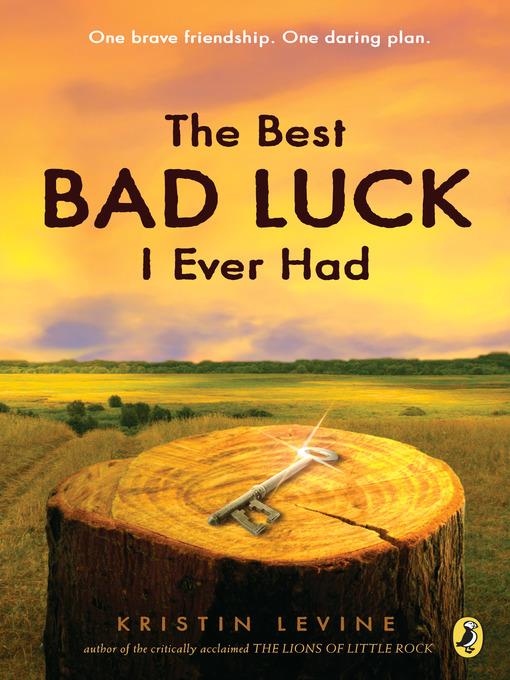
The Best Bad Luck I Ever Had
فرمت کتاب
ebook
تاریخ انتشار
2009
Lexile Score
680
Reading Level
2-3
ATOS
4.2
Interest Level
4-8(MG)
نویسنده
Kristin Levineشابک
9781440699405
کتاب های مرتبط
- اطلاعات
- نقد و بررسی
- دیدگاه کاربران
نقد و بررسی

penguin123 - This book tells the story of Dit, a young boy living in the South during the 1800's while racism is thick. When Emma, a girl who is "colored", moves in, Dit must learn about friendship and seeing more than what's on the outside.

Starred review from December 15, 2008
Tension builds just below the surface of this energetic, seamlessly narrated first novel set in small-town Alabama in 1917. Twelve-year-old Harry, aka Dit, has been looking forward to the arrival of the new postmaster from Boston, said to have a son Dit's age. The “son” turns out to be a girl, Emma, and to everyone's surprise, the family is what Dit calls “colored” and others call “Negras.” Emma, bookish and proud, impresses Dit with her determination (he calls it stubbornness) when she decides to learn to throw a ball or climb, and when Emma's mother upbraids him, Dit begins to rethink what he's been taught about the South's sorrowful defeat in the War Between the States. Levine sets up a climactic tragedy that will challenge the community's sense of justice; although hair-raising Mockingbird–
esque events are becoming common in YA novels about inequality in the segregated South, Levine handles the setting with grace and nuance. Without compromising the virtues and vices of her characters, she lets her readers have a happy-enough ending. Ages 10–up.

December 1, 2008
When 12-year-old Emma Walker comes to Moundville, Ala., with her father, the new postmaster, Harry "Dit " Sims feels it 's "the worst piece of bad luck " he 's ever had. He was hoping for a boy to play ball with but got a "colored " girl instead. But he teaches her to throw and hit a baseball and how to dig a cave, and she teaches him about math and books. Gradually they become best friends and even allies in the rescue of a black barber unjustly jailed and sentenced to hang. Levine draws on her grandfather 's recollections to skillfully delineate the nuances of race relations in a small Southern town in 1917, where kindness and politeness sometimes trumped prejudice and ordinary people found ways to treat each other decently. Dit and Emma are likable protagonists, and the growth of their friendship, along with Dit 's emerging moral conscience, make this a fine debut novel by an author to watch. (Historical fiction. 10-14)
(COPYRIGHT (2008) KIRKUS REVIEWS/NIELSEN BUSINESS MEDIA, INC. ALL RIGHTS RESERVED.)

January 1, 2009
Gr 6-9-This spirited, early-20th-century coming-of-age story presents a small-town cast of well-drawn characters, an unlikely friendship, engaging adventures, and poignant realizations. When a new postmaster arrives in Moundville, AL, 12-year-old Dit is surprised to discover that Mr. Walker is African American and that his refined daughter knows nothing about baseball, hunting, or fishing. With his best friend gone for the summer and in search of companionship other than his nine siblings he reluctantly hangs out with proper, opinionated Emma, who tags along with him asking questions and trying to keep up. Gradually, Dit begins to respect her independence, intelligence, compassion, and determination. But the harsh realities of segregation and racist attitudes threaten their friendship and open Dit's eyes to injustice. After witnessing the town barber's self-defense shooting of the alcoholic and abusive sheriff, Dit and Emma hatch a plan to save the black man's life. Dit's episodic story resonates with youthful authenticity. Peer pressure and racial barbs weigh on his competitive but sensitive spirit. Dit's insular world expands on drives to Selma with Dr. Griffiths, when the influenza epidemic of 1918 invades Moundville, during his pa's shotgun vigil to protect neighbors from nightriders, and in his shared exploits and lively discussions with Emma. Adult characters offer a range of guidance, perspective, and tolerance that helps shape Dit's understanding of his world. Readers will find humor in his candid account, universality in his dilemmas and blunders, and inspiration in his friendship with Emma and their mutual desire for social justice."Gerry Larson, Durham School of the Arts, NC"
Copyright 2009 School Library Journal, LLC Used with permission.

























دیدگاه کاربران